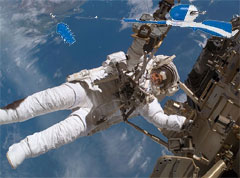Rod and Reel Method May Save International Space Station
Washington, D.C., May 22, 2021 -- A groundbreaking new orbital transportation technique announced by NASA today may hasten the long-delayed completion of the International Space Station (ISS).
 Astronaut Chrissie Buglebong attaches prototype rod and reel device during a dry run simulation
Astronaut Chrissie Buglebong attaches prototype rod and reel device during a dry run simulation
The technique, developed by Russian and NASA scientists in conjunction with the American Angler's Guild, will use an innovative "rod and reel" method to transport crew members, food and supplies to and from the space station, currently in orbit roughly 330 km above the Earth's surface.
"The most serious problem slowing the completion of the ISS, now eleven years behind schedule, has been the expense and risk involved in moving people and supplies there and back again using aging space shuttles or rickety vodka-fueled Russian Soyuz rockets," Dr. Dexter Vectre, a NASA space technician on the ISS project, said. "With Rod & Reel, we can lower the cost of a re-supply or crew change mission by nearly 90% while significantly reducing risks to our astronauts or their cosmonauts."
According to Dr. Vectre, the NASA/RKA Rod & Reel technique involves lowering a laser-guided wire, equipped with its own computer-controlled guidance rockets, from the space station to a receiving station on the ground. Once safely in position, the wire is loaded with either supplies or passengers, then "reeled in" to the ISS.
"The ISS must be moved about 35,400 km up from so-called low-Earth Box orbit into a higher, geostationary orbit prior to 'casting the line'," Dr. Vectre said. "That will make the ISS appear to stand still over a fixed point on the Earth. Otherwise, of course, you'd be scraping a very sharp wire across the surface of the planet at 17,000 miles per hour, which could set NASA and the Russian Space Agency up for some pretty serious liability claims."
Dr. Vectre said there are still "a few small wrinkles" to be worked out before the Rod & Reel technique can be introduced, including how best to economically transport 36,000 km of high-tensile steel wire into space, and how best to achieve the repositioning of the ISS prior to and following any re-supply "cast".
"At the moment, the thinking is that we send up several hundred space shuttles or Soyuz rocket missions over the next five to ten years, each loaded with a big bale of wire," Dr. Vectre said. "ISS wire-tiers will then tie all the wires together into one great big long one.
"For each re-supply mission," Dr. Vectre continued, "an empty shuttle will be sent into space and used to 'push' the ISS into geostationary orbit over a period of about five weeks. When the Rod & Reel re-supply mission is complete, the shuttle would push it back down, then fly home."
Dr. Deeter Pockoff, a ground logistics engineer with NASA, offers a competing approach:
"We are currently sketching plans for a world-wide, sine-wave-shaped electromagnetic monorail that could be activated for use during ISS re-supply missions," Dr. Pockoff said. "Rather than spending the time, fuel, and energy it would take to move the ISS up to geostationary orbit and back again, the ISS will remain exactly where it is, orbiting between 320 and 350 km. The wire, once lowered from the space station, will intersect with our cargo conveyance, already following the ISS's path along the monorail at 17,000 miles per hour. It will connect, lift the cargo or crew off the monorail and simply reel them in. This makes much better sense."
Whatever method is finally implemented, Dr. Vectre said, space enthusiasts worldwide are confident the improved speed and economy of Rod & Reel will soon allow the ISS to finally embark on its vital mission of scientific inquiry, the filming of zero-gravity callisthenics and liquid lunch-related "bloopers" for broadcast on NASA TV.
"It's what makes me proud to be an American," Dr. Vectre said. "Or a Russian, Italian, German, Canadian, or whatever, as the case may be."
By Ion Zwitter, Avant News Editor
Related stories
- Citigroup, Bank of America Announce ATM Instant Equity Exchange Program
- Super Bowl XLIII to Feature Real-time Biometric Player Data
- In Lucky Coincidence, Errant Spy Satellite Strikes Osama
- Pledging "Fresh, Clean Start", Disney Clones Britney
- Cognitive Dissonance May Provide Cure To Non-Existent Global Warming
- President Ron Paul Deported Under Ron Paul's No Amnesty Law
- Windows Vista Startup Music Designed on Macs
- Aliens Announce Completion of Human Observation and Research Program
- Organic Windows Vista Virus Can Target Computers Even When Powered Down
Copyright © 2005-2505 AvantNews.com. All rights reserved.
Avant News contains satire and other fictional material, provided for entertainment purposes only. Disclaimer. Syndicate. Privacy.











